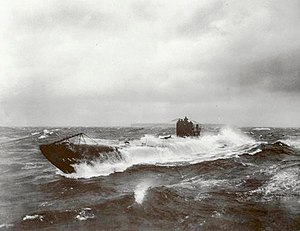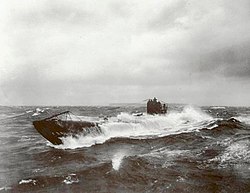SM UB 128
| SM UB 128 (vorheriges/nächstes – alle U-Boote) | ||
|---|---|---|
 Ähnliches Boot: SM UB 148 | ||
| Typ: | UB III | |
| Werft: | AG Weser | |
| Stapellauf: | 10. April 1918 | |
| Indienststellung: | 11. Mai 1918 | |
| Kommandanten: | ||
| Einsätze: | 2 Fahrten | |
| Versenkungen: | ||
| Verbleib: | Am 3. Dezember 1918 an Großbritannien ausgeliefert. 1921 in Falmouth verschrottet | |
SM UB 128 war ein deutsches U-Boot vom Typ UB III der Kaiserlichen Marine während des Ersten Weltkrieges.
Beschreibung
UB 128 wurde von der AG Weser in Bremen gebaut (Kiellegung 20. Juli 1917, Stapellauf 10. April 1918) und am 11. Mai 1918 unter dem Kommando von Kapitänleutnant Wilhelm Canaris in Dienst gestellt.[1]
Wie alle U-Boote des Typs UB III führte UB-128 zehn Torpedos mit sich und war mit vier Bugtorpedorohren, einem Hecktorpedorohr und einem 10,5-cm-Decksgeschütz bewaffnet.[1][2] Die Besatzung bestand aus 3 Offizieren und 31 Mann. Mit zwei Treibölbunkern (35 + 36 t Treiböl) hatte es bei der Überwasserfahrt eine Reichweite von 8.500 sm (15.742 km) bei 6 kn (11,1 km/h). Mit einer Batterieladung kam es unter Wasser bei 4 kn (7 km/h) bis zu 55 sm (102 km) weit. Die Maximalgeschwindigkeit betrug 13,6 kn (25,2 km/h) aufgetaucht und 8 kn (14,8 km/h) unter Wasser.[2] Die Herstellungskosten beliefen sich auf 3.654.000 Mark. Die Länge des Bootes betrug 55,3 m bei einer Breite von 5,8 m und einem Tiefgang von 3,7 m.[2] Es verfügte über zwei Antriebswellen.[2] An jede Antriebswelle war eine 6-Zylinder-Körting-Dieselmaschine mit 550 PS (405 kW) für die Überwasserfahrt und ein Siemens-Schuckert-Elektromotor mit 394 PS (290 kW) für die Fahrt unter Wasser gekuppelt.[2] Die zugelassene Tauchtiefe betrug 50 Meter und die Tauchzeit 30 Sekunden.[1]
Einsätze
Bei der ersten Unternehmung vom 3. August bis zum 4. September 1918 steuerte UB 128 von Kiel um die Färöer in Richtung Mittelmeer. Westlich von Lissabon versenkte es am 21. August den französischen Dampfer Champlain und lief dann in Cattaro ein.[3]
Zur zweiten Unternehmung vom 28. Oktober bis zum 29. November 1918 kam es aufgrund der Räumung der Adria-Stützpunkte: UB 128 musste den Rückmarsch antreten. Nachdem es knapp der Versenkung bei Gibraltar entkommen war, lief UB 128 am 29. November 1918 nach einem Zwischenstopp im norwegischen Kors-Fjord, wo sich die Mittelmeerboote sammelten, in Kiel ein.[3]
Verbleib
Entsprechend den Waffenstillstandsbedingungen wurde das Boot am 3. Dezember 1918 an Großbritannien ausgeliefert und 1921 in Falmouth abgewrackt.
Weblinks
Einzelnachweise
- ↑ a b c Bodo Herzog: Deutsche U-Boote 1906–1966. Karl Müller, 1993, ISBN 3-86070-036-7, S. 60, 73.
- ↑ a b c d e Eberhard Rössler: Geschichte des deutschen U-Bootbaus Band 1. Bernard & Graefe, 1996, ISBN 3-86047-153-8, S. 85–89, 265.
- ↑ a b Harald Bendert: Die UB-Boote der Kaiserlichen Marine 1914–1918. Mittler & Sohn Verlag, 2000, ISBN 3-8132-0713-7, S. 188 f.
Auf dieser Seite verwendete Medien
The former German submarine UB 148 at sea, after having been surrendered to the United States.
U.S. Navy History: "UB-148—a UB.III series, small, coastal submarine— was laid down during the winter of 1917 and 1918 at Bremen, Germany, by Aktiengesellschaft Weser; launched on 7 August 1918; but never commissioned in the Imperial German Navy. She was completing preparations for commissioning when the armistice of 11 November ended hostilities. Two days later, she was interned at the Swedish naval base located at Karls-krona, Sweden, to await her fate. By the terms of the armistice, Germany was required to destroy her aircraft and submarines or surrender them to the Allies. On 26 November, UB-148 was surrendered to the British at Harwich, England. Later, when the United States Navy expressed an interest in acquiring several former U-boats, to use in conjunction with a Victory Bond drive, UB-148 was one of the six boats allocated for that purpose. Her American crew, sent to England early in March 1919, took her over later that month, began preparing her for the voyage to America, and placed her in commission, Lt. Comdr. Harold T. Smith in command. The U-boat departed England on 3 April 1919 in company with Bushnell (Submarine Tender No. 2) and three other submarines—U-117, UB-88, and UC-97. That task organization, the Ex-German Submarine Expeditionary Force, steamed via the Azores and Bermuda to New York, where it arrived on 27 April. After a period of repairs, the submarines were opened for visits by the public. Tourists, reporters and photographers joined Navy technicians and civilian shipbuilders in swarming over UB-148 and the other submarines. Following that, UB-148 received instructions to call at ports along the east coast of the United States in the immediate vicinity of New York City in conjunction with the bond drive. At the conclusion of the drive that summer, she and U-lll were subjected to extensive tests and trials to evaluate their performance capability. When that experimentation ended, she joined U-117 and U-140 at the Philadelphia Navy Yard, where they were laid up pending final disposition. She was dismantled at Philadelphia; and, during the summer of 1921, her hulk was used in gunnery and aerial bombing tests conducted off the east coast. Following those tests, UB-148 was sunk by gunfire from Sicard (DD-346)." [1]
War Ensign of the en:German Empire from 1903-1919 (correction of date shown on image which shows 1918). Based on image of coat of arms at [1]. Currently unable to add further details for crown or further details to sceptor due to lack of high-quality images of the coat of arms.
War Ensign of the en:German Empire from 1903-1919 (correction of date shown on image which shows 1918). Based on image of coat of arms at [1]. Currently unable to add further details for crown or further details to sceptor due to lack of high-quality images of the coat of arms.

